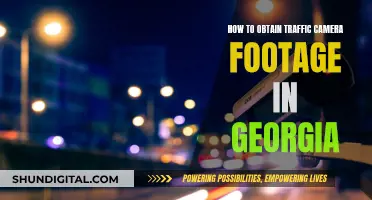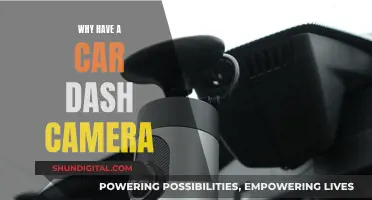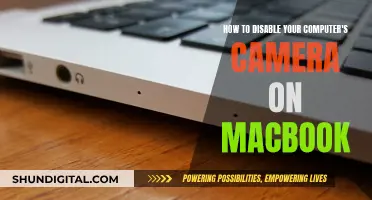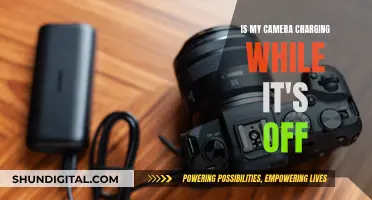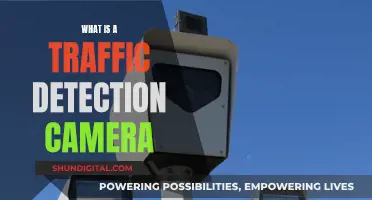
Traffic cameras are highly controversial, raising questions about public safety, privacy, and drivers' rights. While the use of traffic cameras varies by state, they are typically used to enforce traffic signals and speed limits. If you receive a traffic camera ticket, you can fight it by reviewing the photos and videos, checking the relevant state laws, and collecting evidence to support your case. In some cases, you may be able to get the ticket dismissed if the camera was not properly calibrated or maintained, or if there were no warning signs posted. It's important to respond promptly and accurately to a traffic camera ticket and seek legal advice if necessary.
| Characteristics | Values |
|---|---|
| Camera Operation | Cameras are usually affixed to traffic lights and are triggered by sensors when a vehicle passes over them. |
| Ticket Delivery | A ticket is typically mailed to the registered owner of the vehicle within 2 weeks of the violation. |
| Ticket Contents | The ticket includes the fine amount, photo evidence, a copy of the citation, and information on challenging the ticket. |
| Ticket Requirements | A valid ticket must include a clear photo of the driver's face, either through the windshield or a side window. |
| Ticket Challenges | Challenges to a ticket can include the lack of warning signs, an unclear photo, or an unusually short yellow light interval before the red light. |
What You'll Learn

Check the ticket details: date, time, location, and driver
When you receive a traffic camera ticket, it's important to carefully check the details of the ticket, including the date, time, location, and driver information. Here are some reasons why this is a crucial step and what you should look out for:
Date and Time
Check the date and time on the ticket to ensure it aligns with when you were driving the car. This is important because, in some jurisdictions, the prosecutor must prove that you were driving at the specified date and time. If someone else was borrowing your car at that exact moment, you may not be held liable. However, some states, like New York, treat red-light camera tickets as parking violations, holding the registered owner responsible regardless of who was driving. Therefore, understanding the specific laws in your jurisdiction is essential.
Location
Verify the location specified on the ticket. This is crucial because certain jurisdictions have unique laws regarding traffic camera tickets. For example, in L.A. County, you can typically ignore a red-light camera ticket without penalty. Knowing the laws of the location where you received the ticket can help you determine your next steps.
Driver
Confirm that you were indeed the driver of the vehicle at the time of the violation. This is important because, in most states, it is the driver who is liable for the violation, not the vehicle owner. However, some states may treat the registered owner as liable, especially for red-light camera tickets. If someone else was driving, you may need to submit an affidavit stating that fact and providing the driver's information.
In addition to checking these details, it's also a good idea to review any photos or videos included with the ticket to ensure they clearly show your vehicle and that the violation occurred. This can be an essential part of your defence if the evidence is blurry or inconclusive.
Camera Battery Grips: Are They Worth the Hype?
You may want to see also

Plead not guilty and request a hearing
If you want to dispute a traffic camera ticket, you must plead not guilty. Pleading not guilty is the equivalent of requesting a trial. This can usually be done by mail or online, but sometimes you will have to appear at an arraignment.
When you plead not guilty, the judge will set a date for the trial. You will then have to attend any hearings that are scheduled, such as a pre-trial hearing or mediation. At the trial, you will have the opportunity to testify, present witnesses and evidence, and be represented by an attorney.
Before the trial, you should research the law in your area to build a legal defense. For example, there may be requirements for warning signs to be posted near traffic cameras, or for the yellow light interval to be a certain length. If these requirements have not been met, you may have a case for having your citation dismissed.
You can also request production of documents, such as maintenance records for the camera, which may help you establish that the camera was not regularly monitored or maintained.
Wireless Surveillance Cameras: How Long Do Batteries Really Last?
You may want to see also

Research the law and build a defence
The first step in fighting a traffic camera ticket is to examine your ticket. Check the date, time, and location of the ticket. Traffic camera tickets are usually sent to the owner of the car, so make sure you were the one driving the car when the ticket was issued. If someone else borrowed your car, you typically cannot be prosecuted. However, some states, like New York, treat red-light camera tickets like parking violations, holding the registered owner liable. Therefore, it is important to check the specific red-light law in the jurisdiction where you received the ticket.
If you were driving, try to recall the details of the incident, such as whether you were making a legal right turn on a red light. If so, you should be able to get the ticket dismissed. Also, make note of the exact code section you are cited for violating and understand its elements and associated penalties. Remember, it is the prosecution's responsibility to prove each element of your violation.
Now, review the photos and/or videos that came with your ticket. Confirm that the vehicle in the media is indeed yours and that the media is clear. Blurry photos or videos where the license plate is not clearly visible can be used in your defence. Additionally, if there is no identifiable photo of you in the driver's seat, the prosecution may have a harder time proving that you were driving.
At this point, you should also research the applicable laws and defences in your city or county. For example, some states have specific rules about posting warning signs for traffic cameras. If the required signage was obscured or missing, you may have a valid defence. Furthermore, some states recognize a necessity defence for speeding, meaning that even if you were speeding, you may be able to provide a valid reason for doing so.
Building Your Defence
Once you have thoroughly researched the laws and potential defences, it's time to build your case. If you have identified any potential violations of the law or valid defences, gather any evidence you can to support your claims. This may include taking your own photos of the intersection where the incident occurred, reviewing maintenance records for the camera system, or obtaining copies of relevant laws or regulations.
When your hearing date arrives, present yourself professionally and respectfully to the judge and courthouse staff. During the hearing, listen carefully to the prosecutor's case, taking notes on any points you want to address. Then, present your defence, using the evidence you have gathered to support your claims.
Some specific strategies you can use in your defence include:
- Challenging the admissibility of the photograph as hearsay: In some jurisdictions, a red light camera photo may be considered hearsay, which is generally not admissible in court without meeting certain exceptions.
- Asserting your right to confront witnesses: The Sixth Amendment of the Constitution guarantees your right to cross-examine witnesses. If no one from the company that maintains the camera shows up to testify, you may be able to object to the use of the photographs.
- Disputing the authenticity of the photograph: For a photo to be admitted as evidence, the prosecution must prove that the camera, the system connecting it to the traffic light, and the traffic light itself were functioning properly.
- Attacking the lack of evidence: If the photos are clear but do not show you driving, the prosecution may not be able to prove that you were the one driving. Additionally, they must prove that the traffic light was functioning properly.
Inserting a Battery Pack: DX4530 Camera Guide
You may want to see also

Review photo/video evidence and request more if needed
If you've received a traffic camera ticket, the first thing you should do is review the photo and video evidence. This will be included with the ticket you received in the mail, or you may need to wait until after your trial is scheduled to request copies from law enforcement. Check that the photo is clear and that it's definitely your car in the photo. If the license plate isn't clearly visible, it may be difficult to confirm that the car is yours.
If there's no clearly identifiable photo of you in the driver's seat, this can also work in your favour. While you will be under oath, so you can't argue that you weren't driving if you were, you can argue that the prosecution can't prove you were driving. This will only work if you live in a jurisdiction that requires tickets to follow the driver, rather than the registered owner of the car.
If the photo and video evidence is clear and you were driving, you can still request more evidence. Now that you have a court date, call up the local police department or other law enforcement agency in charge of the camera used to issue your citation. Request full maintenance records for the camera and the traffic light or speed monitoring system to establish that they were regularly monitored and maintained. If their accuracy wasn't tested within a short period before your ticket was issued, the photo is potentially unreliable as evidence.
Automatically Numbering in Camera Raw: A Step-by-Step Guide
You may want to see also

Dispute the authenticity of the evidence
If you want to dispute a traffic camera ticket, you must first examine your ticket. Check the date, time, and location of the ticket. As camera tickets are sent to the owner of the car, not the driver, make sure you were driving the car when the ticket was issued. If not, the prosecutor must prove that you were driving in that location at that date and time.
If you were driving, try to remember what you were doing or what was happening at the time, and write down any details you remember. For example, you may have been making a legal right turn on a red light when the camera took the photo. If you were making a legal manoeuvre, you should be able to get the ticket dismissed.
Next, review the photos. If the notification you received included photos, review them to confirm that it is your car in the photo, and that the photo is clear. If the license tag isn't clearly visible, it may be difficult to confirm that the car is yours. If there's no clearly identifiable photo of you in the driver's seat, the prosecution can't prove you were driving, which may be a defence if you live in a jurisdiction that requires tickets to follow the driver, not the registered owner of the car.
If photos were not included with your citation, you may need to wait until after your trial is scheduled to request copies from law enforcement.
Now, you must plead not guilty if you want to dispute the ticket. You can do this by mail or online if your jurisdiction allows. Check your citation and make sure you plead not guilty before the deadline, which is typically within 30 days of receiving the ticket.
If you have no choice, you must appear in traffic court to plead not guilty. Show up at the date and time listed on your citation. This may also be called a first appearance or a notice hearing, depending on your jurisdiction. When you plead not guilty, demand a full formal hearing or trial.
While you're waiting for your hearing, request production of documents. Call up the local police department or other law enforcement agency in charge of the camera used to issue your citation. If photos were not included with your citation, you'll need to request copies of them. You should also request full maintenance records for the camera and the traffic light or speed monitoring system to establish that they were regularly monitored and maintained. If their accuracy wasn't tested within a short period before your ticket was issued, the photo is potentially unreliable as evidence.
Finally, appear at your scheduled hearing. Arrive at the courthouse on the day of your hearing with copies of any documents you intend to use as evidence in your defence. Make sure anything you bring is organised and that you have a clean, professional appearance. Treat the judge and all courthouse staff with respect.
Listen while the prosecutor presents the case against you. The prosecutor will have the first opportunity to speak. Listen quietly, making notes on anything you want to bring up later. Do not interrupt or speak directly to the prosecutor.
Now, you can dispute the authenticity of the photograph. If no one from the company that maintains the camera shows up to testify, object to the use of the photographs for lack of foundation. If you have a camera ticket for speeding, the company or officer who maintained the camera and the speed detection equipment must appear in court to testify or the photo has no foundation to be admitted into evidence.
For the prosecution to rely on the photos, they must present evidence that the camera that took the photo, the system that connected it to the traffic light, and the traffic light itself were functioning properly. Without establishing this foundation that all of these machines are reliable, the photo is not reliable and cannot be admitted into evidence.
Movie Camera Anatomy: Unveiling the Intricate Components
You may want to see also
Frequently asked questions
First, check the date, time, and location of the ticket. Then, review the photos and videos of the incident, which should be available online or by request from the relevant law enforcement agency. If you weren't driving, submit an affidavit with the name and address of the person who was.
If you were driving, common defences include arguing that the yellow light interval was too short, that there were no warning signs, or that the camera had not been properly inspected or calibrated.
Ignoring a traffic camera ticket is generally not advisable, as it is dishonest and can result in fines, increased insurance rates, points on your license, or even license suspension. However, in some jurisdictions, such as L.A. County, you can simply ignore a red-light camera ticket without penalty.


